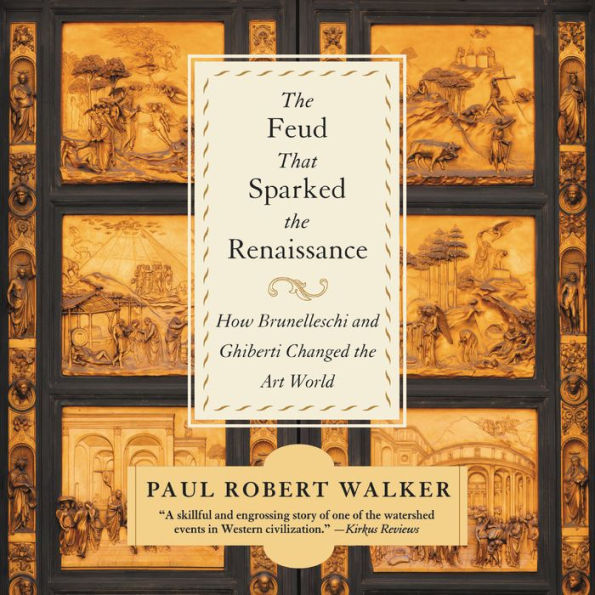A convincing account of one of the defining moments in art and history. Walker offers no new or startling information, but his strength lies in his ability to flesh out the historical framework-while providing enough thoughtful speculation to keep both layman and expert entertained. He presents the two key figures in this drama in true human proportions, stripped of much of the accumulated mythology that has made them appear as unassailable giants in the cultural pantheon. Building upon the earliest biographical account, written several decades after the principals' deaths, Walker establishes the atmosphere of Florence at the beginning of the 15th century as a city-state on the verge of collapse from plague, famine, warfare, religious schism, high taxation, and economic stagnation. With such a backdrop, the Renaissance becomes less a rebirth than a first birth, when the first strains of humanism, individualism, and the artist-as-hero are heard. Lorenzo Ghiberti, the gifted sculptor who designed the panels for the bronze doors of Florence's famous Baptistery, and Filippo Brunelleschi, who later designed the cathedral's dome, are introduced as youthful competitors whose intense rivalry fueled the artistic developments of the next half-century, including emotive realism and the principles of mathematical perspective. Though the account becomes sidetracked at times, such as when the author presents an unnecessary enumeration of fellow artist Donatello's ancestors and a lengthy explanation of one of Brunelleschi's convoluted pranks, these digressions are more embellishments than distractions. Ultimately, the reader is presented with a rich tapestry woven from the tangle of influences whoseconvergence resulted in a seeing of "Man as an active participant in the Universe" and led to the prodigious flowering of the artistic, philosophic, and political movements of the next half-millennium. No research surprises, but a skillful and engrossing story of one of the watershed events in Western civilization. (8 pp. b&w photos, not seen)
Joining the bestsellers Longitude and Galileo's Daughter, a lively and intriguing tale of two artists whose competitive spirit brought to life one of the world's most magnificent structures and ignited the Renaissance
The dome of the Santa Maria del Fiore, the great cathedral of Florence, is among the most enduring symbols of the Renaissance, an equal to the works of Leonardo and Michelangelo. Its designer was Filippo Brunelleschi, a temperamental architect and inventor who rediscovered the techniques of mathematical perspective. Yet the completion of the dome was not Brunelleschi's glory alone. He was forced to share the commission with his archrival, the canny and gifted sculptor Lorenzo Ghiberti.
In this lush, imaginative history-a fascinating true story of artistic genius and personal triumph-Paul Robert Walker breathes life into these two talented, passionate artists and the competitive drive that united and dived them. As it illuminates fascinating individuals from Donatello and Masaccio to Cosimo de'Medici and Leon Battista Alberti, The Feud That Sparked the Renaissance offers a glorious tour of 15th-century Florence, a bustling city on the verge of greatness in a time of flourishing creativity, rivalry, and genius.
Joining the bestsellers Longitude and Galileo's Daughter, a lively and intriguing tale of two artists whose competitive spirit brought to life one of the world's most magnificent structures and ignited the Renaissance
The dome of the Santa Maria del Fiore, the great cathedral of Florence, is among the most enduring symbols of the Renaissance, an equal to the works of Leonardo and Michelangelo. Its designer was Filippo Brunelleschi, a temperamental architect and inventor who rediscovered the techniques of mathematical perspective. Yet the completion of the dome was not Brunelleschi's glory alone. He was forced to share the commission with his archrival, the canny and gifted sculptor Lorenzo Ghiberti.
In this lush, imaginative history-a fascinating true story of artistic genius and personal triumph-Paul Robert Walker breathes life into these two talented, passionate artists and the competitive drive that united and dived them. As it illuminates fascinating individuals from Donatello and Masaccio to Cosimo de'Medici and Leon Battista Alberti, The Feud That Sparked the Renaissance offers a glorious tour of 15th-century Florence, a bustling city on the verge of greatness in a time of flourishing creativity, rivalry, and genius.

The Feud That Sparked the Renaissance: How Brunelleschi and Ghiberti Changed the Art World

The Feud That Sparked the Renaissance: How Brunelleschi and Ghiberti Changed the Art World
FREE
with a B&N Audiobooks Subscription

Editorial Reviews
Product Details
| BN ID: | 2940177329185 |
|---|---|
| Publisher: | HarperCollins |
| Publication date: | 08/04/2020 |
| Edition description: | Unabridged |
Videos

